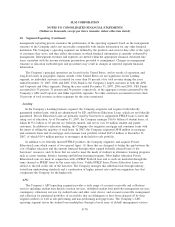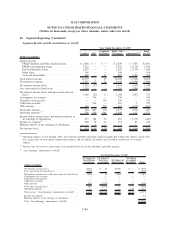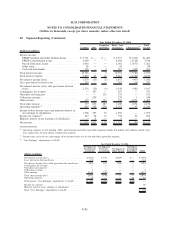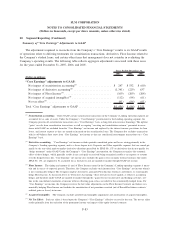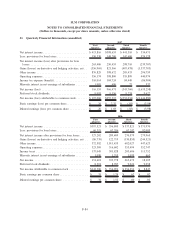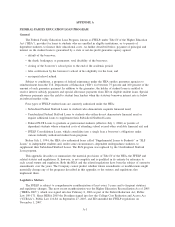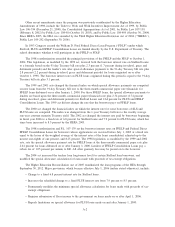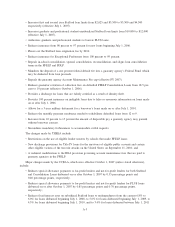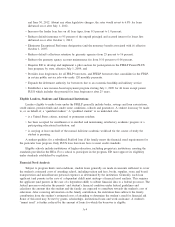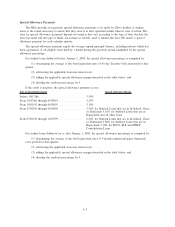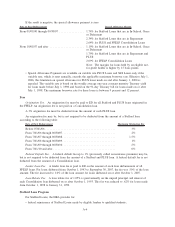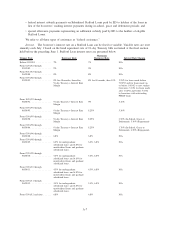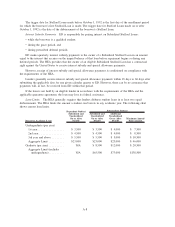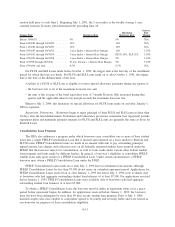Sallie Mae 2007 Annual Report Download - page 209
Download and view the complete annual report
Please find page 209 of the 2007 Sallie Mae annual report below. You can navigate through the pages in the report by either clicking on the pages listed below, or by using the keyword search tool below to find specific information within the annual report.and June 30, 2012. Absent any other legislative changes, the rates would revert to 6.8% for loans
disbursed on or after July 1, 2012;
• Increases the lender loan fees on all loan types, from 0.5 percent to 1.0 percent;
• Reduces default insurance to 95 percent of the unpaid principal and accrued interest for loans first
disbursed on or after October 1, 2012;
• Eliminates Exceptional Performer designation (and the monetary benefit associated with it) effective
October 1, 2007;
• Reduces default collections retention by guaranty agencies from 23 percent to 16 percent;
• Reduces the guaranty agency account maintenance fee from 0.10 percent to 0.06 percent,
• Requires ED to develop and implement a pilot auction for participation in the FFELP Parent PLUS
loan program, by state, effective July 1, 2009; and
• Provides loan forgiveness for all FDLP borrowers, and FFELP borrowers that consolidate in the FDLP,
in certain public service jobs who make 120 monthly payments.
• Expands the deferment authority for borrowers due to an economic hardship and military service.
• Establishes a new income-based repayment program starting July 1, 2009 for all loans except parent
PLUS which includes the potential for loan forgiveness after 25 years.
Eligible Lenders, Students and Educational Institutions
Lenders eligible to make loans under the FFELP generally include banks, savings and loan associations,
credit unions, pension funds and, under some conditions, schools and guarantors. A student loan may be made
to, or on behalf of, a “qualified student.” A “qualified student” is an individual who
• is a United States citizen, national or permanent resident;
• has been accepted for enrollment or is enrolled and maintaining satisfactory academic progress at a
participating educational institution; and
• is carrying at least one-half of the normal full-time academic workload for the course of study the
student is pursuing.
A student qualifies for a subsidized Stafford loan if his family meets the financial need requirements for
the particular loan program. Only PLUS loan borrowers have to meet credit standards.
Eligible schools include institutions of higher education, including proprietary institutions, meeting the
standards provided in the HEA. For a school to participate in the program, ED must approve its eligibility
under standards established by regulation.
Financial Need Analysis
Subject to program limits and conditions, student loans generally are made in amounts sufficient to cover
the student’s estimated costs of attending school, including tuition and fees, books, supplies, room and board,
transportation and miscellaneous personal expenses as determined by the institution. Generally, each loan
applicant (and parents in the case of a dependent child) must undergo a financial need analysis. This requires
the applicant (and parents in the case of a dependent child) to submit financial data to a federal processor. The
federal processor evaluates the parents’ and student’s financial condition under federal guidelines and
calculates the amount that the student and the family are expected to contribute towards the student’s cost of
education. After receiving information on the family contribution, the institution then subtracts the family
contribution from the student’s estimated costs of attending to determine the student’s need for financial aid.
Some of this need may be met by grants, scholarships, institutional loans and work assistance. A student’s
“unmet need” is further reduced by the amount of loans for which the borrower is eligible.
A-4


